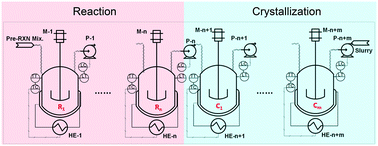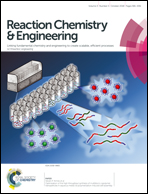Development of an automated multi-stage continuous reactive crystallization system with in-line PATs for high viscosity process†
Abstract
An automated multi-stage continuous reaction system with in-line PATs for a high viscosity reactive crystallization process was developed in the present study. Data acquisition (DAQ) hardware and Labview software were used as the local control system. A “forward-backward” burst pumping strategy was developed to smoothly transfer the highly viscous hot slurry from one vessel to the next. In addition, a comparative analysis between a plug flow reactor (PFR) and continuous stirred-tank reactors (CSTRs) in series revealed that to achieve the same conversion, the latter would require more volume than the former, but less than a single CSTR. For a second-order reaction, the value of the Damköhler number necessary to achieve conversion of 90.0% in a single CSTR is 90. Thus, it is reasonable to approximate a PFR using CSTRs in series to obtain a high yield with a smaller reaction volume (compared with a single CSTR). As the probes could not be positioned in the hot slurry due to fouling issues, in-line focused beam reflectance measurement (FBRM) and React IR were used to monitor the crystal size and reactant concentration in the vessel containing the cold slurry. E-factors of batch and continuous processes were also compared and the continuous reaction could obtain a lower E-factor because less waste was generated.



 Please wait while we load your content...
Please wait while we load your content...